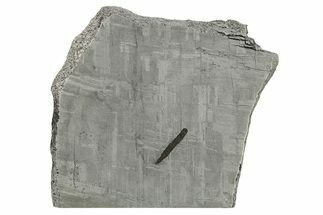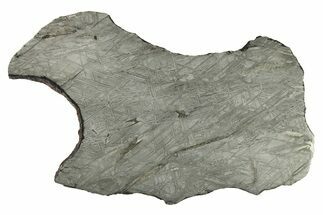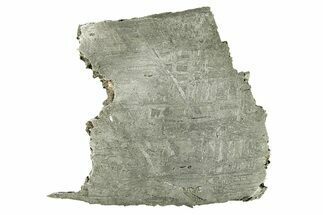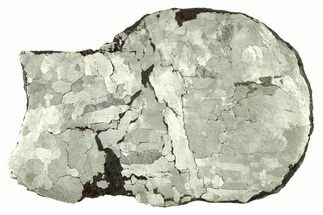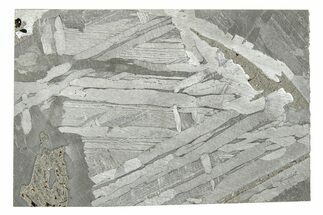This Specimen has been sold.
.9" Etched Muonionalusta Meteorite Cube (80 g) - Sweden
This is a .9" wide (80 gram) cube of the Muonionalusta meteorite collected in Sweden. It shows a very nice Widmanstätten patterns and fully stabilized through reverse electrolysis and coated to prevent rusting.
The Muonionalusta Meteorite
Muonionalusta is one of the oldest known meteorites found on Earth: it is estimated to have impacted around 1,000,000 BCE. It experienced four Ice Ages before it was found in 1906 just west of the Sweden-Finland border in northern Scandinavia, near the Finnish Muonio River. Hence, its name translates as "downstream of the Muonio River" in Finnish. It is an IVA (Nickel-Iron) meteorite, and about 230 kilograms have been discovered from an impact area of about 130 square miles, within the Arctic Circle. It is most likely the ejected mantle or core of a planetoid.
Besides being the oldest and one of the largest meteorites ever discovered, Muonionalusta is also the first meteorite discovered to contain stishovite, a very rare form of quartz formed under immense pressure. A 2010 study using lead isotope dating on the Muonionalusta meteorite concluded the stishovite was from an impact event hundreds of millions of years ago. It indicates that Muonionalusta's parent body was "heavily shocked, possibly during the 0.4 Ga [billion years] old breakup event indicated by cosmic ray exposure".
About forty pieces of the meteorite are housed in various institutions around the world. The largest, weighing about 25 kilograms, is on display at the Moldavite Museum in the Czech Republic. It is popular among collectors for both its staggering age and its spectacular Widmanstätten patterns. Pieces of it have even been used for faces in luxury watches and included in components and paint for special edition luxury cars.
Muonionalusta is one of the oldest known meteorites found on Earth: it is estimated to have impacted around 1,000,000 BCE. It experienced four Ice Ages before it was found in 1906 just west of the Sweden-Finland border in northern Scandinavia, near the Finnish Muonio River. Hence, its name translates as "downstream of the Muonio River" in Finnish. It is an IVA (Nickel-Iron) meteorite, and about 230 kilograms have been discovered from an impact area of about 130 square miles, within the Arctic Circle. It is most likely the ejected mantle or core of a planetoid.
Besides being the oldest and one of the largest meteorites ever discovered, Muonionalusta is also the first meteorite discovered to contain stishovite, a very rare form of quartz formed under immense pressure. A 2010 study using lead isotope dating on the Muonionalusta meteorite concluded the stishovite was from an impact event hundreds of millions of years ago. It indicates that Muonionalusta's parent body was "heavily shocked, possibly during the 0.4 Ga [billion years] old breakup event indicated by cosmic ray exposure".
About forty pieces of the meteorite are housed in various institutions around the world. The largest, weighing about 25 kilograms, is on display at the Moldavite Museum in the Czech Republic. It is popular among collectors for both its staggering age and its spectacular Widmanstätten patterns. Pieces of it have even been used for faces in luxury watches and included in components and paint for special edition luxury cars.
About Iron Meteorites
Iron type meteorites are composed primarily of iron and nickel, and are the remnants of differential cores torn apart at the beginning of the solar system. These metallic meteorites are often the easiest to identify after millions of years post-impact because they are quite different from terrestrial material, especially when it comes to their mass-to-surface area ratio. They are exceptionally heavy for their size since iron is a high-density metal: this is also why the Earth's core is nickel-iron. As planets form, the densest metals form gravitational centers, bringing more and more material into their gravitational pull. In the solar system's rocky planets, these dense materials are most often nickel and iron.
Most iron meteorites have distinctive, geometric patterns called Widmanstätten patterns, which become visible when the meteorite is cut and acid etched. These patterns are criss-crossing bands of the iron-nickel alloys kamacite and taenite that slowly crystalized as the core of the meteorites' parent bodies slowly cooled. Such large alloy crystallizations for mover millions of years and do not occur naturally on Earth, further proving that iron meteorites come from extraterrestrial bodies.
Iron type meteorites are composed primarily of iron and nickel, and are the remnants of differential cores torn apart at the beginning of the solar system. These metallic meteorites are often the easiest to identify after millions of years post-impact because they are quite different from terrestrial material, especially when it comes to their mass-to-surface area ratio. They are exceptionally heavy for their size since iron is a high-density metal: this is also why the Earth's core is nickel-iron. As planets form, the densest metals form gravitational centers, bringing more and more material into their gravitational pull. In the solar system's rocky planets, these dense materials are most often nickel and iron.
Most iron meteorites have distinctive, geometric patterns called Widmanstätten patterns, which become visible when the meteorite is cut and acid etched. These patterns are criss-crossing bands of the iron-nickel alloys kamacite and taenite that slowly crystalized as the core of the meteorites' parent bodies slowly cooled. Such large alloy crystallizations for mover millions of years and do not occur naturally on Earth, further proving that iron meteorites come from extraterrestrial bodies.
TYPE
Iron (IVA)
LOCATION
Sweden
SIZE
.9 x .85 x .85", Weight: 80 grams
CATEGORY
SUB CATEGORY
ITEM
#271196
 Reviews
Reviews
